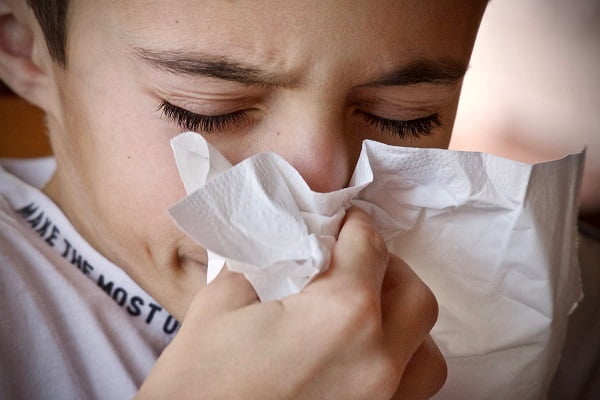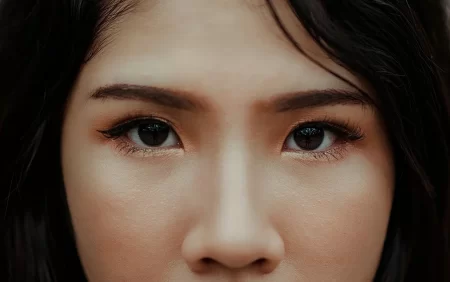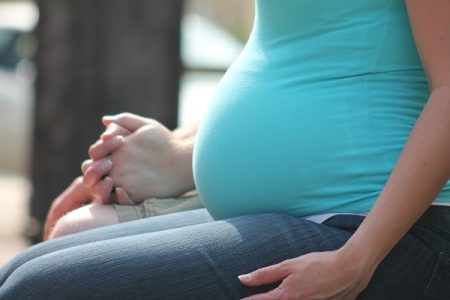Allergic Rhinitis in Children
- Updated on: Jul 10, 2024
- 4 min Read
- Published on Sep 19, 2019


Rhinitis is an inflammation and swelling of the mucous membranes of nose because of a reaction that occurs in the eyes, nose, and throat when some substances (allergens) in the air cause the release of histamine in the body. The released histamine causes itching, swelling, and a fluid buildup in the fragile linings of nasal passages, sinuses, and eyelids.
Rhinitis can be seasonal or perennial. Seasonal rhinitis occurs due to a reaction to seasonal allergens, which are present in some specific seasons only like pollens. However, perennial rhinitis occurs due to an allergic response to perennial allergens, which are present throughout the year like dust, smoke, microbes, pet hair and dander etc. Rhinitis is of two main types – allergic rhinitis and non-allergic rhinitis.
Allergic rhinitis: It is also called hay fever and usually occurs due to an allergic response to some allergy-causing substances (allergens) like grass, weeds, pollens etc. This type of rhinitis can affect both children as well as adults. In children, it can affect infants, toddlers and kids of different ages.
Non-allergic rhinitis: This type of rhinitis is found mostly in adults. It is not caused by any allergic reaction, instead is triggered by substances like odors, perfumes, seasonal changes, weather, some medications etc.
Allergic Rhinitis in Children
Allergic rhinitis in children occurs due to an allergic reaction to some allergens (allergy causing substances), which results in the release of histamine in the body. The released histamine causes swelling, itching, irritation and fluid buildup in the mucous membranes of nose, sinuses and eyelids. Allergic rhinitis in children can either occur in some specific seasons or throughout the year, however the latter one is more common in younger children. It mostly occurs in children with a family history.
Allergic rhinitis in children usually presents in early childhood and is caused by an immunoglobulin E (IgE)-mediated reaction to various allergens in the nasal mucosa. Sensitization to outdoor allergens can occur in rhinitis in children above the age of 2 years, however, sensitization to outdoor allergens is commonly found in children older than 4 to 6 years of age. Clinically significant sensitization to indoor allergens usually occurs in children younger than 2 years of age. Some of the common indoor allergens include dust mites, pet danders, cockroaches, molds, and pollens.
Allergic rhinitis is also called hay fever. Many children with allergic rhinitis are often susceptible to allergic conjunctivitis (eye allergy).
Symptoms in Children
Allergic rhinitis is most commonly found in children from families with a history of the disease. It is not possible for parents to control absolutely all substances that can cause rhinitis in their children; however parents can focus on monitoring the symptoms in their children. Some of the common symptoms of allergic rhinitis in children are:
- Development of rashes or hives on skin e.g., eczema and atopic dermatitis
- Breathing problems like asthma
- Stomach problems
- Sneezing
- Coughing
- Running nose
- Eye allergies
- Itchy skin
- Nose bleeding
- Dripping of mucus from the nose
- Snoring
- Breathing through the mouth
- Poor academic performance due to health issues
Causes
Allergic rhinitis in children may be caused either by some seasonal allergens like pollens or perennial allergens like dust, smoke, odors, microbes etc. Some of the common allergens that cause allergic rhinitis in children are:
- Irritants like car exhaust, smoke, odors, perfumes
- Outdoor allergens like pollens, weeds, grass, insect bites
- Food allergens like milk products, peanuts, eggs, milk
- Indoor allergens like dust, pet hair or dander, mold, dust mites, cockroach waste etc
Risk Factors for Allergic Rhinitis in Children
Children with breathing problems like asthma are at a higher risk for rhinitis. Allergic rhinitis is a common problem linked to asthma; however, this association is not completely understood. Besides, children having a family history of allergic rhinitis are also at a higher risk. Some experts think that since rhinitis makes it hard for children to breathe through their nose, therefore it is harder for the nose to work normally. In such cases, children prefer mouth breathing but breathing through the mouth does not warm, filter, or humidify the air which has to enter the lungs. As a result the impure air makes asthma symptoms worse in children. Therefore, controlling asthma may help control allergic rhinitis in some children.
Which Children are at Risk for Allergic Rhinitis?
Children with other allergic diseases like eczema, food allergy, and asthma are more prone to allergic rhinitis. It has been found that almost 8 out of 10 children with asthma also have allergic rhinitis. In these children, allergens are a common cause of asthma attacks. Besides, children whose parents have allergies are also at greater risk of developing allergic rhinitis. Therefore, controlling allergies may help in controlling asthma and eczema in such children.
Diagnosis
The diagnosis of allergic rhinitis in children is typically made by a child’s healthcare provider thorough medical history and physical exam. During a physical examination, the child’s provider may find following things:
- Swelling of nasal tissues
- Dark circles under the eyes
- Creases under the eyes
Healthcare provider may refer the child to an allergist to know the actual cause of these symptoms.
Treatment
The treatment of allergic rhinitis in children (pediatric allergic rhinitis) is usually based on the following:
- Age of the child
- Health history and overall health of the child
- Response of the child to specific medicines, procedures, or therapies
- How sick is the child
- How long the allergy is expected to last
The various treatment options for allergic rhinitis in children are:
- Allergy shots
- Antihistamines
- Decongestants
- Nasal sprays
- Medicines for controlling asthma
How Can Allergic Rhinitis be Prevented in Children?
Allergic rhinitis in children can be prevented by taking following measures:
- Avoiding pollen exposure during pollen seasons, such as wearing masks
- Avoiding exposure to dusts, mites, molds etc
- Keeping homes clean so as to avoid exposure to indoor allergens
- Avoiding pets
- Maintaining hygiene
- Avoiding food allergens
- Managing asthma symptoms











